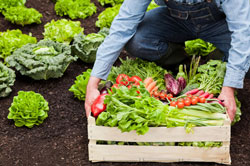Organic mulches are organic materials that, when laid on the soil, decompose to feed soil microorganisms and improve the quality and texture of the soil. If the mulch you've put down is decomposing quickly, add nitrogen to make up for nitrogen consumed by bacteria.
Compost: Partially decomposed compost looks a little rough, but it makes a great mulch and soil conditioner.
Lawn Clippings: Do not use clippings from a lawn that has been treated with a herbicide or weed killer; these substances can kill the vegetables you're trying to grow. Let untreated clippings dry before putting them around your garden; fresh grass mats down and smells bad while it's decomposing.
Leaves: Leaves are cheap and fairly easy to find, but they are sometimes hard to keep in place. They will stay in place better if they're ground up and partially decomposed. Do not use walnut leaves! They contain iodine, which is toxic to some vegetable plants. Nitrogen should be added to leaves.
Sawdust: Sawdust is often available for the asking, but it requires added nitrogen to prevent microorganisms from depleting the soil's nitrogen supply. If possible, allow sawdust to decompose for a year before using it as a mulch.
Straw: Straw is messy and hard to apply in small areas, but it is an excellent mulch. Be sure not to use hay, which contains many weed seeds.
Wood Chips or Shavings: Wood chips, like sawdust, decompose slowly and should be allowed to partially decompose for a year before being used as mulch. Additional nitrogen will be needed to supply bacteria during decomposition.


